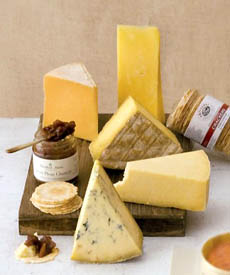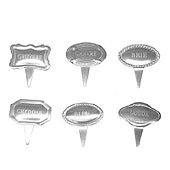

Let them eat cheese! Invite your friends over for a party that is sure to delight. You can build a cheese party around a theme, such as the British cheeses shown above, available as a gift collection at ArtisanalCheese.com.
June 2005
Updated July 2009
|
 |
Cheese Tasting Party
Page 2: Serving The Cheese
This is Page 2 of a three-page article. Click on the black links below to visit other pages.
Serving Cheese
Depending on the size of the group, you can create individual plates, pass one cheese plate around the table, or have people serve themselves from a buffet.
Have the right tools to slice the cheeses. After all your hard prep work, you don’t want things to crumble at the appointed hour.
- Soft, crumbly cheeses like chevres and blues can fall apart when cut, even with the sharpest knife. Professionals use a wire to ensure accurate, straight cuts (see the wire cheese cutter below; it is also available as a metal implement without the board). Wire substitutes include guitar strings (the thin, treble clefs) or unflavored dental floss pulled tight between your thumbs and forefingers.
- Soft, ripe cheeses with rinds like Brie and Camembert require a sharp, thin paring knife. Dip the knife in hot water before cutting.
- Hard cheeses like Cheddar and Parmesan require a large chef’s knife.
- Have a different utensil for each cheese, so the flavors don’t mingle.
The goal in slicing cheese is to cut equal portions and avoid giving someone an end piece that’s mostly rind.
- With round cheeses that’s easy: just cut the wheel into pie-shaped wedges.
- With rectangular pieces, slice lengthwise so that each person has a piece of the rind at the tip, like the tip of a matchstick.
Serve the cheeses at room temperature. Cold cheeses do not showcase their textures, aromas and flavors. The cheeses should be out of the refrigerator at least one hour before serving. Keep the cheeses covered until you are ready to serve them so they do not begin to dry out. However, if your kitchen is warm, you may wish to remove any tight plastic wrap and cover the cheese in waxed paper, so it does not “sweat.”
Select cheese condiments. Some people are purists: they believe nothing should be eaten with the cheese to get in the way of its flavors. Others believe that serving accompaniments with cheese is as important as serving condiments or sides with other great foods.
- These can be fresh and dried fruits and fruit pastes, chutneys, nuts, honey, mostardas and a variety of spreads. Aged balsamic is a classic pairing with parmesan and other aged, hard cheeses. Breads and crackers run the gamut from bland (baguette and water biscuits) to flavorful (currant and walnut breads, raisin semolina, wheatmeal biscuits).
- There is so much to choose from, we’ve written an entire Guide to Cheese Condiments.
Choose a serving platter. In less creative times, cheese was served on a “cheese board.” Today, a cheese board is anything you wish to serve the cheese on—whether an official cheese board, an all-purpose platter, a wooden cutting board, a slab of granite, a straw mat. Just be sure the surface can bear the blade of a knife without damage.
Slice In Style
 |
 |
 |
| Stainless Steel Cheese Markers: These stainless steel cheese markers identify your cheese in an attractive fashion. Click here for more information. |
Prodyne Beechwood Cheese Tray with Cracker Well: This attractive wire cheese slicer and serving tray features a handy recessed well for serving crackers. Click here for more information. |
Henckels Twin Select Cheese Slicer: This beautiful stainless steel Twin Select cheese slicer offers superior craftsmanship and performance. $9.99. Click here for more information. |
Go To Page 3: Tasting Cheese
Go To Article Index Above

|







